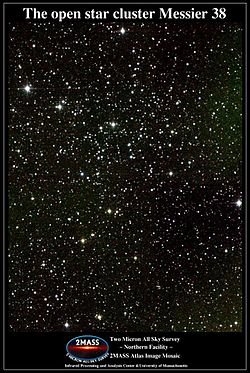- Messier 38
-
Messier 38 
M38 open cluster, source: NOAOObservation data (J2000.0 epoch) Constellation Auriga Right ascension 5h 28m 42s Declination +35° 51′ 18″ Distance 4.2 kly (1.3 kpc) Apparent magnitude (V) 7.4 Apparent dimensions (V) 21′ Physical characteristics Radius 25 ly Estimated age 220 Ma Other designations NGC 1912 See also: Open cluster, List of open clusters Messier 38 (also known as M38 or NGC 1912) is an open cluster in the Auriga constellation.
It was discovered by Giovanni Batista Hodierna before 1654 and independently found by Le Gentil in 1749. M36 and M37, also discovered by Hodierna, are grouped together with M38 at a distance of about 3,420 light years away from Earth.[1]
The cluster's brightest stars form a pattern resembling the Greek letter Pi or, according to Webb, an "oblique cross." At its distance of 4,200 light years, its angular diameter of about 20' corresponds to about 25 light years, similar to that of its more distant neighbor M37. It is of intermediate age (about 220 million years, according to Sky Catalog 2000) and features a yellow giant of apparent magnitude +7.9 and spectral type G0 as its brightest member. This corresponds to an absolute magnitude of -1.5, or a luminosity of 900 suns. For comparison, the Sun would appear as a faint magnitude +15.3 star from the distance of M38.
Walter Scott Houston described its appearance as follows:[2]
Photographs usually show a departure from circularity, a feature quite evident to visual observers. Older reports almost always mention a cross shape, which seems more pronounced with small instruments. A view with a 24-inch reflector on a fine Arizona night showed the cluster as irregular, and the host of stars made fruitless any effort to find a geometrical figure.
Contents
Components
NAME Right ascension Declination Spectral type HD 35519 05h 26m 54.3176s +35° 27' 26.181 K2 NGC 1912 HOAG 2 B5II-III NGC 1912 HOAG 3 NGC 1912 HOAG 4 05h 28m 35.39s +35° 52' 51.2 A0V NGC 1912 HOAG 5 05h 28m 50.73s +35° 46' 47.2 A0Vn NGC 1912 HOAG 6 05h 28m 10.46s +35° 55' 26.0 A0:V NGC 1912 HOAG 7 05h 28m 34.25s +35° 53' 29.7 A2V NGC 1912 HOAG 11 NGC 1912 HOAG 19 K2IIIb NGC 1912 HOAG 104 G5III NGC 1912 SS G2 NGC 1912 HOAG 128 K0III NGC 1912 SS G4 A5:V NGC 1912 HOAG 153 K0V NGC 1912 SS G3 A3V NGC 1912 HOAG 160 K1IV NGC 1912 HOAG 161 G5V NGC 1912 HOAG 171 G7IV NGC 1912 HOAG 172 References
- ^ Majaess D. J., Turner D., Lane D. (2007). "In Search of Possible Associations between Planetary Nebulae and Open Clusters". Publications of the Astronomical Society of the Pacific 119: 1349. arXiv:0710.2900. Bibcode 2007PASP..119.1349M. doi:10.1086/524414.
- ^ Houston, Walter Scott (2005). Deep-Sky Wonders. Sky Publishing Corporation. ISBN 1931559236.
External links
- Messier 38, SEDS Messier pages
- Messier 38 on WikiSky: DSS2, SDSS, GALEX, IRAS, Hydrogen α, X-Ray, Astrophoto, Sky Map, Articles and images
See also
Messier objects List M1 · M2 · M3 · M4 · M5 · M6 · M7 · M8 · M9 · M10 · M11 · M12 · M13 · M14 · M15 · M16 · M17 · M18 · M19 · M20 · M21 · M22 · M23 · M24 · M25 · M26 · M27 · M28 · M29 · M30 · M31 · M32 · M33 · M34 · M35 · M36 · M37 · M38 · M39 · M40 · M41 · M42 · M43 · M44 · M45 · M46 · M47 · M48 · M49 · M50 · M51 · M52 · M53 · M54 · M55 · M56 · M57 · M58 · M59 · M60 · M61 · M62 · M63 · M64 · M65 · M66 · M67 · M68 · M69 · M70 · M71 · M72 · M73 · M74 · M75 · M76 · M77 · M78 · M79 · M80 · M81 · M82 · M83 · M84 · M85 · M86 · M87 · M88 · M89 · M90 · M91 · M92 · M93 · M94 · M95 · M96 · M97 · M98 · M99 · M100 · M101 · M102 · M103 · M104 · M105 · M106 · M107 · M108 · M109 · M110See also  Book:Messier objects ·
Book:Messier objects ·  Category:Messier objects
Category:Messier objects  Portal:Astronomy
Portal:AstronomyCoordinates:
 05h 28m 42s, +35° 51′ 18″Categories:
05h 28m 42s, +35° 51′ 18″Categories:- Open clusters
- Messier objects
- NGC objects
- Auriga constellation
- Star cluster stubs
Wikimedia Foundation. 2010.

